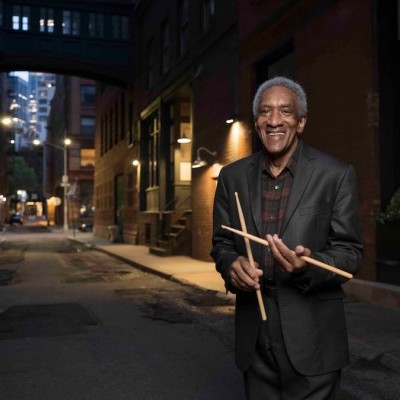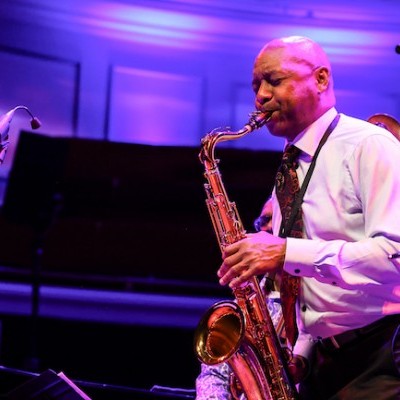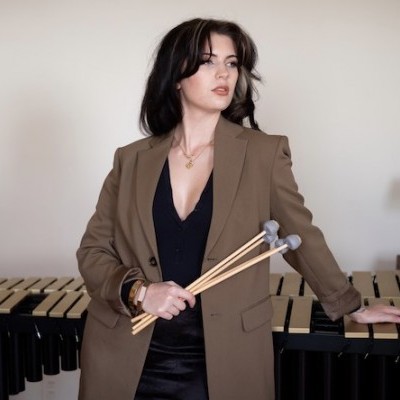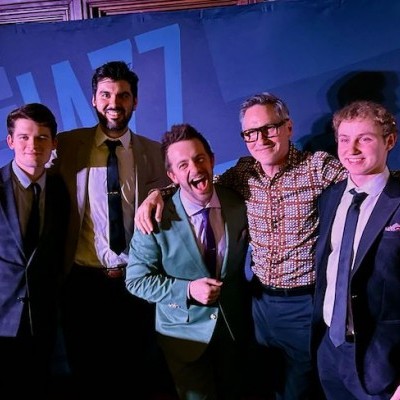Jun 3, 2025 11:25 AM
In Memoriam: Al Foster, 1943–2025
Al Foster, a drummer regarded for his fluency across the bebop, post-bop and funk/fusion lineages of jazz, died May 28…
This August, Newport Jazz Festival celebrates 70 years. What began in 1954 with a single cardboard soundstage at Newport Casino has become a four-stage experience at Fort Adams State Park featuring craft vendors, beer gardens, charging and nursing stations and rows of tented merch. But what makes Newport one of the world’s most beloved festivals is the music and, by extension, the musicians. To help celebrate the intrepid event’s 70th anniversary, DownBeat reprises its just-one-question series, speaking with this year’s artists about professional ethos, global leadership and cycles of the creative process. The fest takes place Aug. 2–4 at Fort Adams State Park in Newport, Rhode Island. CLICK HERE to view the complete lineup.
Danilo Pérez / Newport set: Danilo Pérez, John Patitucci, Terri Lyne Carrington & Ravi Coltrane: The Legacy of Wayne Shorter
You’ve spoken about “mastering the minimal” as a restraint-centered approach; for example, earlier in your career, you created very focused etudes for McCoy’s compositions. These practices, many coming from your time with Wayne, have further empowered you to liberate your imagination on the bandstand. How have you applied this artistic approach to the complex work you do engaging different stakeholders as a global music ambassador?
In leadership, mastering the minimal translates to identifying core values and priorities and ensuring, in more complex scenarios, that everybody’s in tune with that. One of the greatest lessons we got from Wayne was to create a space where talented individuals can contribute to the innovation process. He [rejected] the idea of “myself, alone” and always embraced the “collective genius” of the project. It’s the same [practice] being a global ambassador: the idea of shifting from individuality to the collective and recognizing the collective capacity that we have, if we are inclusive. Being from Panama, which is a cultural crossroads, my belief in diversity and inclusion is very integrated into leadership. I see beauty and potential in very challenging situations, and the ability for transformation.
Aneesa Strings / Newport sets: Aneesa Strings; Newport at 70
A recent listen of your 2019 release Ways changed my perception of the vamp section on “What You Need,” which got me thinking how the relevance of works can evolve over time. How do you allow new readings of your past recordings and existing music to inform your creative process in the present?
Once I put out a body of work, I rarely go back and listen to it. It takes so much effort to get it from conception to recording to mixing and mastering, and then marketing that by the time it’s out you’re sick of it [laughs]. Going through that process of making an album inspires you to write other things. Usually, by the time you have a body of work that you’re finishing up, you have a whole new sound in your head. So the role that it plays is a catalyst for change. You get tired of that sound: “Alright, I want to do something else.” That’s the way previous projects influence you. You’re not even proud of it anymore [laughs]: “Well it’s cool, but you should hear what I’m doing now.” So it propels you to take risks and to put yourself in places you may not have put yourself before.
Johnathan Blake / Newport sets: Johnathan Blake Pentad; Bill Frisell Four; Kenny Barron Trio
In the decade since your first leader hit at Newport, you’ve been prolific with Pentad, Trion and your Jazz Gallery commission My Life Matters. As you’ve matured in your leader career, what have you started seeking in collaborative projects that may have been different when you were younger and had more time and energy to devote to other people’s music?
When choosing to collaborate on someone’s project, the first thing I ask is, “Does the music move me?” I never want to be part of a project if I’m not wholeheartedly into it. As an up-and-coming musician, I sometimes did projects that were more so for a financial situation — so sometimes I said yes to projects for the wrong reason. Learning other people’s music takes time away from other things; I always want to make sure I’m invested in it, because if I don’t, then I feel like, “Man, I could be doing something with my kids.” So first and foremost, the music has to reach my heart. [Then] I ask, “Do I get along with the other musicians?” If I get along with them both musically and personally, then the music will reach a higher plateau. And from playing with luminaries like Kenny and Bill, I’ve learned how selective they are when it comes to projects. Now I see why they’re like that.
Noriko Ueda / Newport set: Artemis
In high school, you gravitated toward the bass in your pop band; later, toward the walking bass line. In your performing bands, you create a strong foundation with real plasticity that inspires risk-taking and spontaneity. How has your relationship with your instrument informed your approach to composing and orchestrating?
What I like most about the role of bass in jazz is its ability to allow me to feel the harmony from the bottom end, coordinate the rhythm with drums, and make counter lines with [any instrument]. [These conversations] often happen spontaneously during performances. When I compose or write arrangements I like to work with the color, doubling the melody with different instruments, octaves, in any number in the different ranges — flute and muted trumpet, clarinet and trombone, trumpet, soprano saxophone and tenor saxophone, etcetera. Because I love to play the unison bass line with piano, I often use that technique for small band arrangements. I’m generally trying to use more space in the writing or playing, so the music itself can breathe.
Kenny Barron / Newport set: Kenny Barron Trio
You’re here with what critics have described as a “classic trio.” From a creativity perspective, what’s invaluable about performing with a working band, and with Kiyoshi and Johnathan in particular?
When your working band has been together for a long time, you start to breathe as one. You kind of anticipate each other’s moves and how you’re going to respond. It’s difficult to explain but you just feel each other. Kiyoshi’s been with me 30 years and Johnathan’s been with me about 20. I may start to play something we’ve never played before and they’ll find a way into it. Eventually it’ll be an arrangement. Playing in a situation like that makes it very comfortable — not safe, but comfortable. They feel free to take chances and when they take chances, it does something for everybody. It makes me play a different way. When somebody does something different, everybody responds. That’s the fun of it. DB

Foster was truly a drummer to the stars, including Miles Davis, Sonny Rollins and Joe Henderson.
Jun 3, 2025 11:25 AM
Al Foster, a drummer regarded for his fluency across the bebop, post-bop and funk/fusion lineages of jazz, died May 28…

“Branford’s playing has steadily improved,” says younger brother Wynton Marsalis. “He’s just gotten more and more serious.”
May 20, 2025 11:58 AM
Branford Marsalis was on the road again. Coffee cup in hand, the saxophonist — sporting a gray hoodie and a look of…

“What did I want more of when I was this age?” Sasha Berliner asks when she’s in her teaching mode.
May 13, 2025 12:39 PM
Part of the jazz vibraphone conversation since her late teens, Sasha Berliner has long come across as a fully formed…

Roscoe Mitchell will receive a Lifetime Achievement award at this year’s Vision Festival.
May 27, 2025 6:21 PM
Arts for Art has announced the full lineup for the 2025 Vision Festival, which will run June 2–7 at Roulette…

Benny Benack III and his quartet took the Midwest Jazz Collective’s route for a test run this spring.
Jun 3, 2025 10:31 AM
The time and labor required to tour is, for many musicians, daunting at best and prohibitive at worst. It’s hardly…